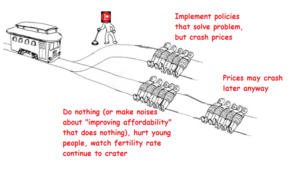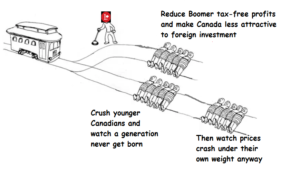Rare Disease Day: TTP and Caplacizumab
February 28th, 2023 by PotatoIt’s rare disease day, so let’s look back on TTP, the rare disease that Wayfare had/has.
Thrombotic Thrombocytopenia Purpura
The tense is hard with TTP. It’s a sudden, short-term, life-threatening blood disorder. But even once the antibodies retreat as mysteriously as they appeared and the platelet count goes back to normal, it’s never really gone. There’s a good chance a survivor received organ damage from the clots or bleeding during a TTP attack, which may manifest as brain, kidney, liver, or heart damage — or just about anything else.
But beyond that, there’s the fear that it will come back. Roughly half of patients will at some point have another TTP attack, each of which carries with it a risk of dying during the episode, and accumulating more permanent organ damage and disabilities.
Wayfare essentially has PTSD from her rare disease. It took over a week and several visits to urgent care and the hospital before her TTP was finally diagnosed correctly and treatment started. By that point, she had so few platelets remaining that they had to call a vascular surgeon in to the ICU to do a cut-down on her leg to access a vein. They couldn’t run a central line because if it happened to bleed, she’d bleed out before they could stop it. In the leg at least they had the option of sacrificing the leg and tourniquetting it if the line went poorly.
We can’t afford to wait that long if she has a relapse, but the first signs of a potential relapse are fairly every-day occurrences. So any headache, any mysterious bruise (or one with a known cause that doesn’t look to be healing fast enough), any splotching on the skin, any time she feels maybe more tired than normal… these are all potential medical emergencies and we have to get her blood taken. Every few months we are off to the blood lab on short notice, or sometimes straight to the hospital to check.
Fortunately, there’s a new drug available that can help. She was part of the clinical trial, and was out of the hospital weeks sooner than they had predicted when she went in. Who knows how bad the strokes may have been if she hadn’t got it?
In Which Potato Learns How Drugs are Approved
Being in medical research, but not drug development itself, I thought I had an above-average idea of how drugs get to patients: Someone has an idea, it goes through pre-clinical testing, then clinical trials (Phases 1, 2, and 3) then reviewed by Health Canada, then ta-da, new drug on the market!
Caplacizumab went through all that. It’s safe and effective. Health Canada approved it. But TTP patients in Canada still can’t get it.
We can’t even choose to pay out of pocket for it.
There’s one more critical step: the drug has to make it onto a provincial formulary, the listing of drugs available for purchase somewhere in the province.
A big influence there is CADTH, which makes a cost-benefit analysis. In our case, they decided to recommend against caplacizumab, which as someone with expertise in a related field, who’s done a lot of reading into TTP for obvious reasons, I cannot understand why. Nearly every other nation that’s completed their equivalent review has approved it — if Wayfare gets sick again, we may be best served by putting her on a flight to the US or UK, ’cause their patients can get caplacizumab.
Reading their report, they seem to have mis-understood the feedback patients sent in, saying that we were concerned about the risk of a relapse but the clinical trial didn’t address that question. The subtext is that the company is welcome to fund another clinical trial to answer that question, after which CADTH may re-visit the decision. But that’s insane, no company is going to do that for a rare disease, especially for a tiny country like Canada if the big countries have already approved it!
And that isn’t the point we were making! The point is that caplacizumab works. It works to stop the early disease process where the platelets are forming tiny clots just fucking everywhere and ruining your very best brain tissue and nephrons. It gives you time for the conventional therapy (plasma exchange) to do its job and clear the bad antibodies that kicked the whole cascade off. It gets people out of hospital sooner and with fewer long-term disabilities.
And not just the first time. Half of TTP patients will have a relapse. Some of them have multiple relapses per year. Every time they relapse, they run that permanent organ damage and disability gauntlet: will it be a stroke this time? Will they lose a kidney? Will it affect their energy levels a little, or will everything get all scrambled so much they put the sugar in the coffee maker and the coffee in the cup in the mornings and just cry about how awful their coffee is, unable to make the connection about how to fix the problem?
We wanted them to consider that these risks don’t hit TTP patients just once, they’re a risk every relapse. Cutting those risks down by some significant percentage (the exact number would need more trials but the anecdotal evidence suggests it’s somewhere in the 50+% range) is huge if you have to face that risk over and over again — it compounds. A 10% risk of disability with each attack becomes a 40% chance after 5 relapses. Cutting just 5 percentage points off that risk doesn’t sound like a big deal when you only consider the initial attack in the cost-benefit analysis, but after a few years that’s half as many TTP survivors with a disability.
And more than the hard economics of the cost-benefit analysis: nobody out there knows if they might get TTP. It’s super-rare, you may not have heard about it before now. But once you’ve had your first attack, you live with that constant fear that you might be one of the unlucky ~50% who will have a relapse. You live with PTSD, the constant triggers that any little every day thing might be the first sign of a relapse. Knowing caplacizumab is there to improve your odds if you do relapse would be a huge mental benefit even if you never actually need the drug yourself.
The other side of the cost-benefit was also hard to understand: it’s a niche, antibody-based drug, so it’s somewhat expensive, yes. But it’s not like a take every day forever kind of drug, more like an epi-pen: an emergency rescue medication taken during an acute episode to help buy time for other treatments to work, saving lives and tissue in the process.
Political Action
Right now, the patient group Answering TTP is sending a letter to some of the provincial leaders. It’s still possible for these leaders to choose to make caplacizumab available in their province — CADTH’s report is a recommendation only, it is ultimately a province-by-province decision.
Rare disease day doesn’t just have to be about awareness, we can also help improve treatment with a small step of getting a Health Canada-approved drug for a rare disease into the hands of the Canadian patients who need it.
So please, fire off an email to your province’s health minister, and CC your MPP. Or tweet at them and tell them CADTH made a whoopsie, it happens, but maybe they can go ahead and add caplacizumab to their formulary this rare disease day.
Thanks in advance from me.
Nitpicking
Screw it, I’m clearly never getting a job at CADTH, let’s burn some bridges and nitpick that CADTH report to show you why I just don’t get why this wasn’t instantly approved and lauded as a modern medical marvel!
“During the overall study period, a statistically significantly (P = 0.0004) lower percentage of patients in the caplacizumab group (nine patients; 12.7%) compared to the placebo group (28 patients; 38.4%) experienced recurrence of aTTP…”
Holy fucking shit, how is this not approved on that alone?!?! Yes, above I focused so much on the part they missed, about reducing the risk associated with each relapse, but it also pretty convincingly reduced the risk of relapses themselves in a statistically significant way!
“The submitted price of caplacizumab is $6,200 per 11 mg dose. Assuming 37.2 days of therapy (i.e., the mean exposure to caplacizumab for patients in the active treatment group of the HERCULES trial; the reported maximum was 65 days), the cost of caplacizumab for an aTTP episode is $236,840 per patient…”
That’s the worst-case cost. And like in many clinical trials, they didn’t really know what dosing regimen to use. I would place a sizeable bet that caplacizumab would give almost all of the benefits in a 10-day course costing just $62,000. The mechanism of action strongly suggests to me that it works best early on, and the anecdotes from other patients we’ve heard of include many dramatic turn-arounds in the first week or so. But if you’re running a clinical trial you’re not going to take a chance on that, you’re going to flood the study participants with the medication and be sure it works, and do some real-world evidence gathering to fine-tune the dosage later. More to the point, if Wayfare had a recurrence, she would instantly pay $62,000 out of pocket to get a 10-day course of caplacizumab… if it were available to Canadian patients to purchase in the first place. But CADTH only considered the all-or-nothing case of using the same dosing regimen as the clinical trial.
Indeed, the real-world experience in the UK is that they are tapering down the dosing regimen, stopping when levels are normalized, rather than continuing all the way through plasma exchange. A few years ago their average days of use was already down to ~30, and is likely lower now (as a non-expert pointing to the outfield, I tell ya, 10 days).




 Questrade: use QPass 356624159378948
Questrade: use QPass 356624159378948 Passiv is a tool that can connect to your Questrade account and make it easier to track and rebalance your portfolio, including the ability to make one-click trades.
Passiv is a tool that can connect to your Questrade account and make it easier to track and rebalance your portfolio, including the ability to make one-click trades.